The Vetrarblót, meaning “Winter Sacrifice” in Old Norse, was an important festival in the Norse calendar marking the arrival of winter. Traditionally held in late October or early November, it was a time to honour the gods, the ancestors, and the spirits of the land as the dark half of the year began. Communities gathered to give thanks for the harvest and to seek protection, strength, and good fortune through the long winter ahead.
The festival was dedicated to several deities associated with winter, survival, and fate, such as Odin, Freyr, and the disir – female ancestral spirits believed to watch over families. Offerings of food, drink, and sometimes animals were made to ensure prosperity and to maintain balance between the human world and the divine. Feasting, drinking, storytelling, and song were central to the celebration, reinforcing bonds between kin and community while honouring the cycles of nature.
Vetrarblót also marked a spiritual shift. It was a time for reflection, remembrance, and preparation. The warmth of the hearth, the sharing of mead, and the telling of old sagas symbolised unity and endurance against the cold. Fires were lit to drive away darkness and to celebrate life in the face of winter’s challenges.
In modern times, Vetrarblót is celebrated by those who follow Norse and pagan traditions as a way to reconnect with heritage and the rhythms of the natural world. Gatherings often include candlelit rituals, seasonal foods, and toasts to the gods and ancestors. It remains a powerful reminder of the Norse respect for nature’s cycles, the strength of community, and the importance of honouring both life and death as part of an eternal balance.
The Vetrarblót was not tied to one single location — it was celebrated throughout Scandinavia, wherever Norse communities lived. Each settlement, farmstead, or region held its own version of the festival, often with local customs and deities emphasised.
However, some notable centres of worship where large communal blóts (sacrificial feasts) are believed to have taken place include:
- Uppsala, Sweden – One of the most important cult centres in Norse religion, Uppsala hosted grand sacrifices to the gods, particularly to Odin, Thor, and Freyr. Archaeological and written sources suggest seasonal festivals such as the Vetrarblót were held there.
- Trondheim (Nidaros), Norway – A significant regional centre during the Viking Age, where midwinter and harvest rites were performed to honour the gods and ancestors.
- Hofstadir, Iceland – Excavations at Hofstadir in Mývatn show evidence of feasting and animal sacrifice linked to winter and harvest festivals.
- Lejre, Denmark – A major ceremonial and political centre where seasonal rituals, including Vetrarblót and Yule, are thought to have been held.
In smaller communities, the Vetrarblót was typically hosted by a chieftain or goði (pagan priest) at a local hof (temple) or farmstead hall. People gathered to offer food and drink to the gods and spirits, feast together, and strengthen social bonds before the hardships of winter.



